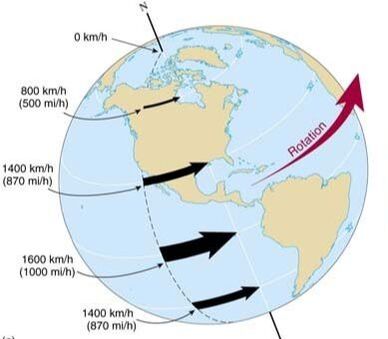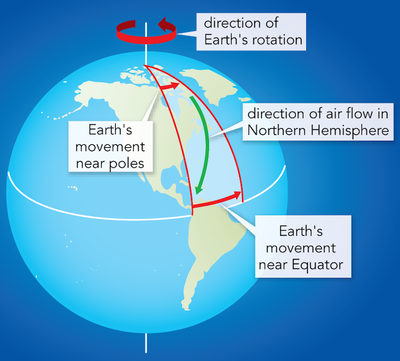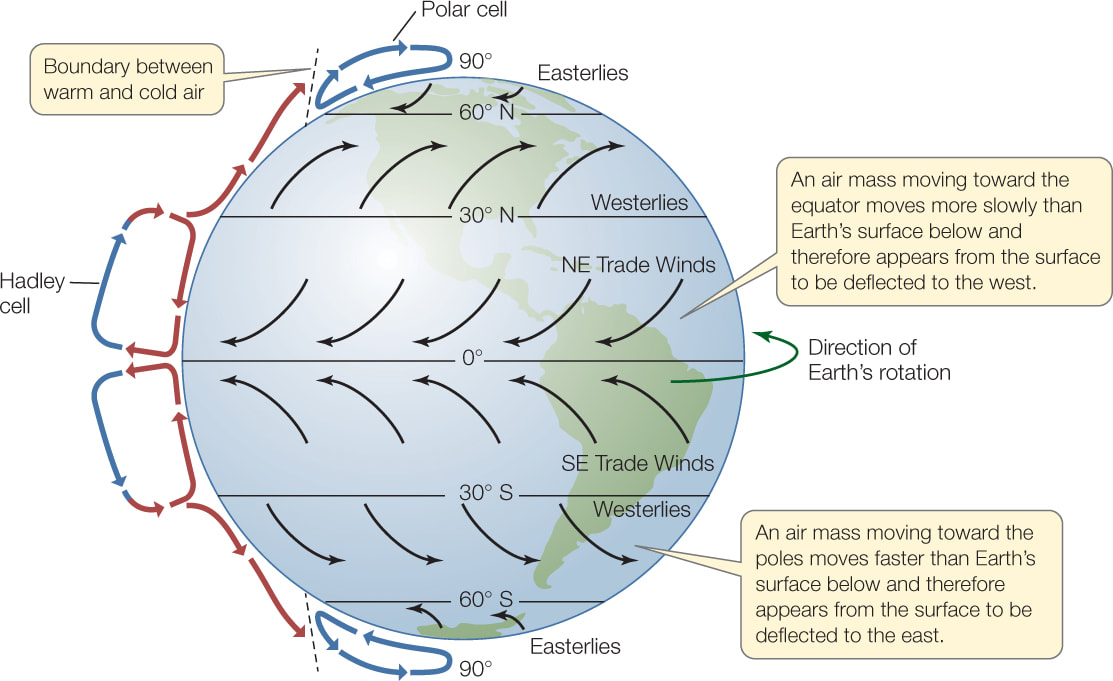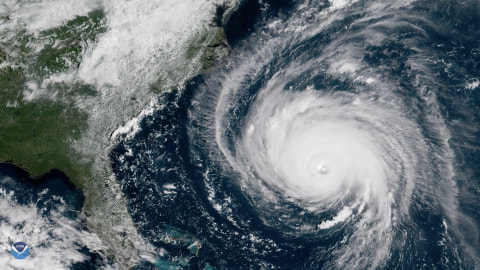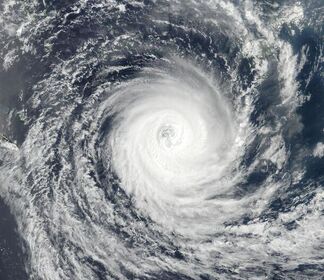|
Oceanography >> Circulation and Climate >> Coriolis Effect
|
3.2 - The Coriolis Effect
Objectives:
- To know that the different parallels of latitude have different surface velocities and understand why.
- To understand the consequences of this on large scale movement of fluids.
- To know that in the Northern hemisphere moving objects are deflected to the right.
The Coriolis Effect is sideways deflection of a moving object due to the spin of the Earth. It is a consequence of Newton's First Law of Motion that says that all objects will continue to move in a straight line at a constant speed unless acted on by an external force. As the radius of the Earth effectively gets smaller as we move closer to the poles, its surface velocity decreases. It has less distance to travel in the same \(24\,\text{hr}\) period. The speed at any given point on the Earth's surface can be calculated using:\[v=\frac{2\pi r\cos{\theta}}{T}\]
For example - given that the radius of the Earth is \(6370\,\text{km}\) and that Bermuda is at \(32^{\circ}\) we get:
\[v=\frac{2\pi\,6370\cos{32}}{24}\]
\[v=1400\,\text{km/hr}\]
For example - given that the radius of the Earth is \(6370\,\text{km}\) and that Bermuda is at \(32^{\circ}\) we get:
\[v=\frac{2\pi\,6370\cos{32}}{24}\]
\[v=1400\,\text{km/hr}\]
|
Sometimes it can be hard to get around the fact that different latitudes rotate at different speeds as they are on the same object that is rotating at the same rate! Another hard concept to understand is JUST HOW FAST the surface of the Earth is moving. Enough to make you dizzy.
|
Why does this cause a deflection?
Assume that there is an airplane above the equator flying north from the Galapagos Islands heading to New rleans. It has TWO components to its motion: the northwards velocity from its engines and the eastwards velocity from the Earth's rotation. As it flies north at a constant speed, its eastwards velocity is now greater than the velocity of the surface of the Earth rotating under it. It appears to have deflected to the east (right). The further north it flies, the greater the apparent deflection.
Assume that there is an airplane above the equator flying north from the Galapagos Islands heading to New rleans. It has TWO components to its motion: the northwards velocity from its engines and the eastwards velocity from the Earth's rotation. As it flies north at a constant speed, its eastwards velocity is now greater than the velocity of the surface of the Earth rotating under it. It appears to have deflected to the east (right). The further north it flies, the greater the apparent deflection.
|
The same plane lands somewhere in the far north and takes off again to fly south to New Orleans. It again has two velocity components: the southwards velocity from the engines and the eastwards velocity from the rotation of the Earth. Now as it flies south its eastwards velocity is slower than that of the surface of the Earth. The Earth has revolved faster under the plane, so it appears to be deflected to the west (also right). This analysis works in every direction of motion that is not directly east-west. The result is that in the northern hemisphere all moving objects are deflected to the right. The further they go, the more the deflection.
It is important to realise that the Coriolis Effect is not special physics, but purely a consequence of Newton's First Law. |
The Coriolis Effect can only be observed for large scale systems as the differential speed of the surface of the Earth changes very slowly with latitude. So any notion that it affects water going down a plug hole is just daft.
Consequences for Circulation
This effect causes the convection currents of the world to be deflected to the right in the northern hemisphere. Air moving to the south is deflected to the west, air moving to the north deflected to the east. For example: the air at the surface moving south from \(30^{\circ}\text{N}\) is deflected to the west and end up blowing from the north east. As these very predictable winds blew steadily from the Canary Islands to the Caribbean they were called the Trade Winds. The northerly winds blowing from the Mid-latitude cell from \(30^{\circ}\text{N}\) to \(60^{\circ}\text{N}\) are deflected to the east and are our prevailing southwesterlies.
As we will find out later, these winds also drive the surface currents of the ocean.
Consequences for Circulation
This effect causes the convection currents of the world to be deflected to the right in the northern hemisphere. Air moving to the south is deflected to the west, air moving to the north deflected to the east. For example: the air at the surface moving south from \(30^{\circ}\text{N}\) is deflected to the west and end up blowing from the north east. As these very predictable winds blew steadily from the Canary Islands to the Caribbean they were called the Trade Winds. The northerly winds blowing from the Mid-latitude cell from \(30^{\circ}\text{N}\) to \(60^{\circ}\text{N}\) are deflected to the east and are our prevailing southwesterlies.
As we will find out later, these winds also drive the surface currents of the ocean.
Other Resources
|
|
The bit from 7:51 onwards shows the Coriolis Effect in action.
|
